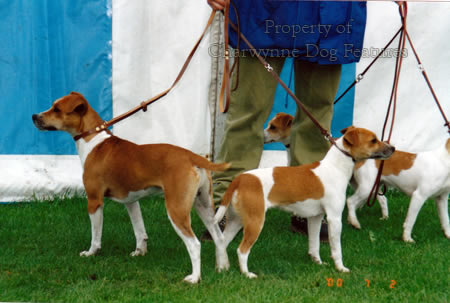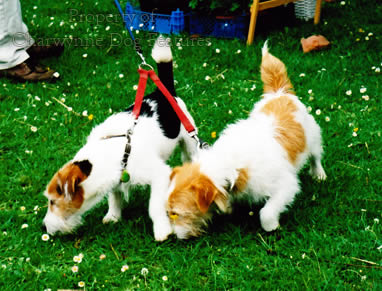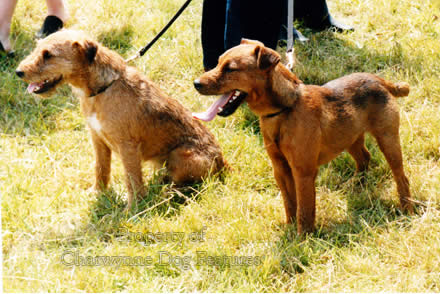868 IS BREED RECOGNITION A BENEFIT
IS BREED-RECOGNITION A BENEFIT?
by David Hancock
 Few sportsmen would argue that the recognition of a terrier breed by the Kennel Club is always a benefit. A glance at the show ring specimens in so many terrier breeds indicates the loss of true type as well as thoughtless exaggeration. The length of coat alone in breeds like the Scottish Terrier and the Soft-coated Wheaten Terrier shows the perils of KC-recognition and inevitable show ring exaggeration. The leglessness of the Skye and the absurd head demanded of the Bull Terrier demonstrate too how the show ring can produce unwelcome features in what was an established breed-type. When terrier-men abandon breeds like the Fox Terrier, the Kerry Blue and the West Highland White and show no interest in breeds like the Welsh Terrier and the Manchester Terrier that have clear potential, makes a point for me. The Border Terrier and many Cairn Terriers retain type and soundness but there is a world of difference between the show Bedlingtons and Sealyhams and those still worked.
Few sportsmen would argue that the recognition of a terrier breed by the Kennel Club is always a benefit. A glance at the show ring specimens in so many terrier breeds indicates the loss of true type as well as thoughtless exaggeration. The length of coat alone in breeds like the Scottish Terrier and the Soft-coated Wheaten Terrier shows the perils of KC-recognition and inevitable show ring exaggeration. The leglessness of the Skye and the absurd head demanded of the Bull Terrier demonstrate too how the show ring can produce unwelcome features in what was an established breed-type. When terrier-men abandon breeds like the Fox Terrier, the Kerry Blue and the West Highland White and show no interest in breeds like the Welsh Terrier and the Manchester Terrier that have clear potential, makes a point for me. The Border Terrier and many Cairn Terriers retain type and soundness but there is a world of difference between the show Bedlingtons and Sealyhams and those still worked. 
For the devotees of emergent terrier breeds like the Plummer, the Lucas, The Sporting Lucas and the Fell/Patterdale Terriers there is an understandable hesitation before taking that crucial step and approaching the KC. Some of these breeds are already registered with the UKC in America, so that a breed standard can be established and breed type set out in a word picture. But what is the value of a precise and wordy standard if breeders, exhibitors and even judges, subsequently ignore or even re-invent it? I recall having conversations with Brian Plummer about this and understood he was in two minds about KC-recognition. The KC never hesitates to recognise a 'new' terrier breed as their swift registration, as a breed, of the Cesky Terrier, a newly-created bre ed from abroad, demonstrates. Of course, the Parson Russell breed recognition here does prevent overseas kennel clubs from grabbing such a type as theirs and bred to their design. Short-legged Australian Jack Russells might still gain international acknowledgement however as the FCI, or international kennel club, widens its scope.
ed from abroad, demonstrates. Of course, the Parson Russell breed recognition here does prevent overseas kennel clubs from grabbing such a type as theirs and bred to their design. Short-legged Australian Jack Russells might still gain international acknowledgement however as the FCI, or international kennel club, widens its scope.
Coming on to the terrier (by name) scene now we can find: American Toy Terriers, Toy Fox, Brazilian and Japanese Terriers, with non-sporting so-called terrier breeds - like the Tibetan and Boston, confusing the canine dictionary. For me, Britain and Ireland is the spiritual home of terriers and should exert a right to reserve the noun 'terrier' for sporting breeds only. I could see it being reserved for true 'earth-dogs' and breeds like the Airedale renamed, as the French would as griffons, rough-coated all-round sporting dogs. I have long disliked the description 'Toy Terrier'; it's a contradiction in terms and encourages shameful practices such as the use of 'hand-bag dogs' as ornamental possessions not as sentient creatures at our mercy. The diminutive Yorkshire Terrier, so exploited by humans and now bred for its length of coat and sheer ti niness, shows what can happen whenthe title 'sporting' disappears from its description. We lost that charming breed, the English White Terrier, to show ring excess. Perhaps its restoration to our lists would prove that national breeds are valued, not just exploited then neglected.
niness, shows what can happen whenthe title 'sporting' disappears from its description. We lost that charming breed, the English White Terrier, to show ring excess. Perhaps its restoration to our lists would prove that national breeds are valued, not just exploited then neglected.
Britain, of course, is not alone in neglecting such dogs. Half a century ago, you could still find schnauzers on remote German farms that looked like Lakelands in every way. They kept the rats down and were valued as workers. It took the Dutch a long time to revive their Smoushond, once much more like a working Wheaten Terrier. The Belgians never classed their Schipperke as a terrier breed despite its prowess as a ratter and its terrier-like phenotype. The pinscher breeds do represent the terrier-type in both Austria and Germany but the show ring has altered their conformation substantially. That, perhaps, is the risk so many terrier-breed enthusiasts fear most: the financial rewards of showing a nd breeding small terriers, under a breed title - whether deserved or not, and in violation of its function as an earth-dog, with the anatomy to succeed as such. For me, terrier breeds have to be honest; their founding function has to be respected.
nd breeding small terriers, under a breed title - whether deserved or not, and in violation of its function as an earth-dog, with the anatomy to succeed as such. For me, terrier breeds have to be honest; their founding function has to be respected.
Perhaps uniquely, I have judged Plummer Terriers, Lucas Terriers and Sporting Lucas Terriers at their respective annual shows. I liked the people and the dogs, many of whom could have done a terrier's job and certainly looked the part. Could it be that we need a new body torecognise and regulate them, an offshoot of the Countryside Alliance or the Rare Breeds Trust for farm animals? When I say regulate them I don't mean over-zealous control but the observance of a defined word picture for each emergent sporting terrier breed, so that at least we know their size and shape. I just hope that such admirable terrier breeds don't fall victim to some ambitious clique or succumb to some weird desire for exaggeration, just as far too many of their KC-registered cousins sadly have. The terrier breeds of Britain, recognised or not, form part of our sporting heritage and thoroughly merit our very best endeavours to conserve them.